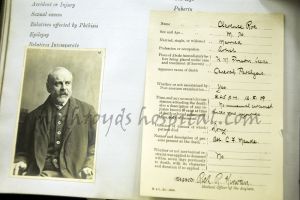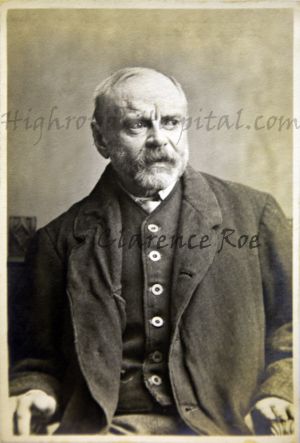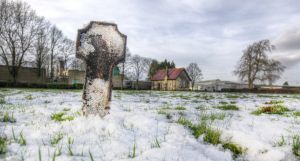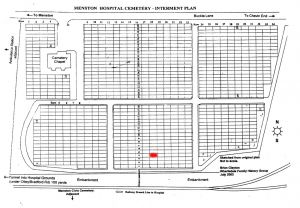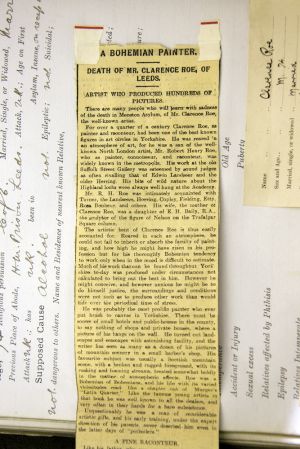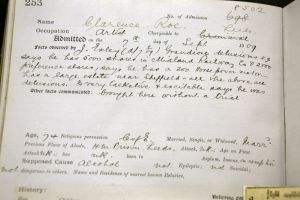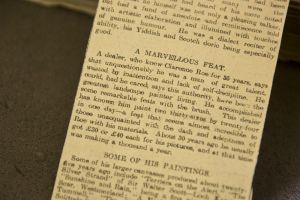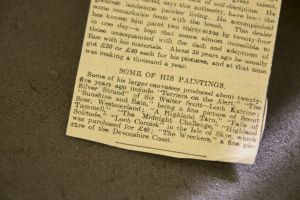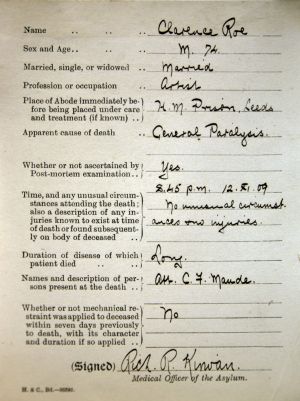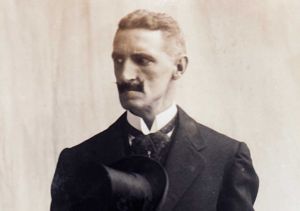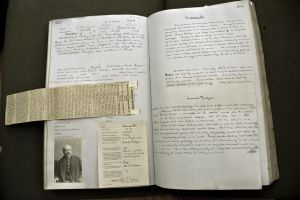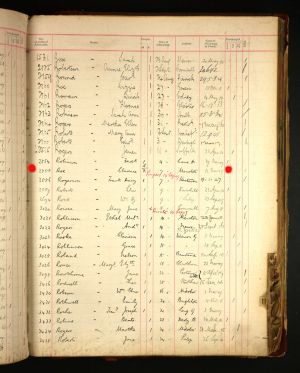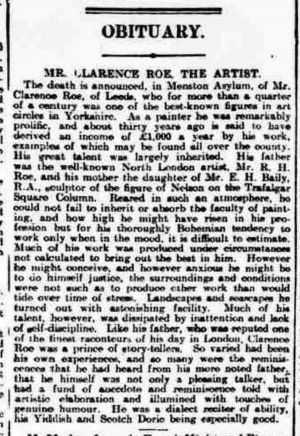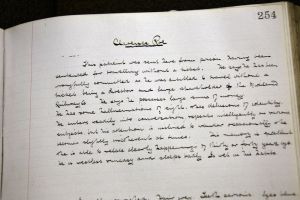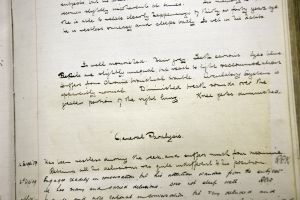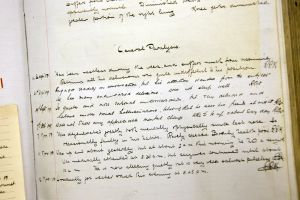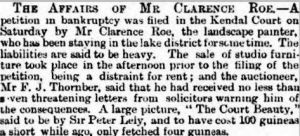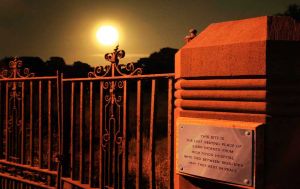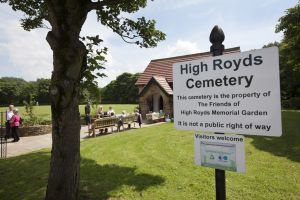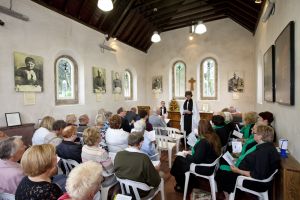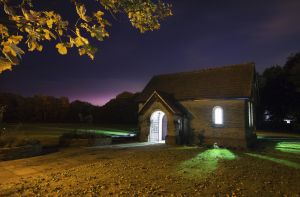Yorkshire Landscape Artist Clarence Roe
Death In The Asylum (High Royds Hospital)
Obituary
November 1909
A Bohemian Painter
Death Of Mr. Clarence Roe Of Leeds
ARTIST WHO PRODUCED HUNDREDS OF PICTURES
There are many people who will learn with sadness of the death in Menston Asylum, of Mr. Clarence Roe, the well-known artist.
For over a quarter of a century Clarence Roe, as painter and raconteur, had been one of the best known figures in art circles in Yorkshire. He was reared in an atmosphere of art, for he was the son of the well-known North London artist, Mr. Henry Roe, who as painter, connoisseur, and raconteur, was widely known in the metropolis. His work at the old Suffolk St Gallery was esteemed by sound judges as often rivalling that of Edwin Landseer and the older Herring. His bits of wild nature about the Highland Lochs were always well hung at the Academy. Mr. H Roe was intimately acquainted with Turner, the Landseers, Herring, Copley, ~Fielding, Etty, Rosa, Bonheur and others. His wife, the mother of Clarence Roe, was a daughter of E. H. Baily, R.A the sculptor of the figure of Nelson on the Trafalgar Square column.
The artistic bent of Clarence Roe is thus easily accounted for. Reared in such an atmosphere, he could not fail to inherit or absorb the faculty of painting, and how he might have risen in his profession but for his thoroughly Bohemian tendency to work only when in the mood is difficult to estimate. Much of his work that can be found throughout Yorkshire to-day was produced under circumstances not calculated to bring out the best in him. However he might conceive, and however anxious he might be to do himself justice, the surroundings and conditions were not such as to produce other work than would tide over the periodical time of stress.
A FINE RACONTEUR
Like his father, who was reported to be one of the finest Raconteurs of his day in London, Clarence Roe was a prince of story tellers. So varied had been his own experiences and so many were the reminiscences that he had heard of his more noted father that he himself was not only a pleasing talker, but he had a fund of anecdote and reminiscence told with artistic elaboration and illumined with touches of genuine humour. He was a dialect reciter of ability, his Yiddish and Scotch doric being especially good.
A MARVELLOUS FEAT
A dealer who knew Clarence Roe for 35 years, says that unquestionably he was a man of great talent, wasted by inattention and lack of self-discipline. He could, had he cared, says this authority, have been the greatest landscape painter living. Ha accomplished some remarkable feats with the brush. This dealer had known him paint two thirty-sixes by by twenty-fourin one day- a feat that seem almost incredible to those unacquainted with the dash and adeptness of Roe with his materials. About 30 years ago he usually got £30 or £40 each for his pictures, and at the time was making a thousand a year.
SOME OF HIS PAINTINGS
Some of his larger canvasses produced about twenty- five years ago include “Terriers on the Alert,” “The Silver Strand,” of Sir Walter Scott- Lock Katrine; “Sunshine and Rain,” being a fine picture of Scout Scar, Westmorland; “The Midnight Challenge,” “Highland Solitude,” “Loch Cornisk” in the Isle of Skye, which was purchased for £40; “The Wreckers,” a fine picture of the Devonshire coast.
_________________________
Clarence Roe – Artist
Reception to the Menston Pauper Lunatic Asylum (High Royds Hospital.)
Name: Clarence Roe
No of admission: 698, crossed out replaced with 8502
Occupation: Artist
Chargeable to: Criminal, then crossed out and replaced with Leeds
Admitted on the: 7th day of September 1909
Religious persuasion: Church of England
Married, Single or Wdidowed: Married
Previous place of Abode: HM Prison Leeds
Attack: Unknown
Age on 1st attack: Unknown
Asylum: Has not been in any Asylum
Insane: On reception
Supposed Cause: Alcohol
Epileptic: Not
Suicidal: Not
Name of nearest known relative: Not stated.
Relatives similarly affected: Not stated
Facts observed by J Exley: Grandiose delusions eg, says he has 5000 shares in the Midland Railway Co & 2000 preference shares, says he has a 200 horsepower motor – has a large estate near Sheffield – all of the above are delusion. Is very talkative and excitable says he was brought here without a trial.
Other facts communicated: This patient was sent here from prison, having been sentenced for travelling abroad without a ticket. He says he has been wrongfully committed as he was entitled to travel without a ticket being a director and large shareholder of the Midland Railway Co. He says he possesses large sums of money. He has some hallucinations of sight. These delusions are of identity. He enters readily into conversation repeats intelligently on various subjects but his attention is inclined to wander occasionally, he becomes slightly incoherent at times. His memory is excellent. He is able to relate clearly happenings of thirty or forty years ago. He is restless uneasy and sleeps badly and wet in his habits.
Mental and Physical State: Is well nourished. Hair grey, teeth erosion, eyes blue, pupils are slightly unequal, but react to light accommodation. Suffers from chronic bronchial trouble. Circulatory system is apparently normal. Diminished breath sounds over greater portion of the right lung. Knee jerks diminished.
General Paralysis.
14 September 1909: Has been restless during the week and suffers much from insomnia. Restless and his delusions are quite indifferent to his position.
21 September 1909: Engages readily in conversation but his attention wanders from the subject. He has many and varied delusions. Does not sleep well. RPK
29 September 1909: Is quieter and more rational in conversation but very deluded and labours under visual hallucinations, believing that he sees his friends at night. RPK
7 October 1909: Does not show any applicable mental change. Able to labour every day. RPK
7 November 1909: Has degenerated greatly both mentally physically since last note. Bodily health poor. RPK
11 November 1909: Was up and about yesterday, but at about 2am this morning he had a seizure and was medically attended at 230 am, but seizures continued until about 10 am. He is now sleeping quietly but is very weak and almost paralysed. RPK
12 November : Gradually got weaker and died at 8.45pm Dr R P Kirwan.
Post Mortem
Apparent Cause of death: General Paralysis of the insane.
Whether or not ascertained by post Mortem: Yes
Time and any unusual circumstances attending the death also a description of any injuries known to exist at the time of death or found subsequently on the body of the deceased: 8,45pm 12 November 1909 – No unusual circumstances and no injuries.
Duration of disease of which patient died: Long
Name and description of person present at the death: Attendant C Maude
Signed: Medical officer Rich P Kirwan
WYAS, Wakefield office, ref: C488/7/29 http://www.wyjs.org.uk/archives-wakefield.asp
——————————————-
Clarence Henry Roe, the Victorian and Edwardian British landscape painter today, in 2014 lies in an unmarked paupers grave at the former Menston Pauper Lunatic Asylum. Clarence, born in Brimingham in 1850 was a pupil of the Royal Academy in London. An habitual drinker he was admitted into the asylum in September 1909 and died soon after on 12th November 1909.
He was laid to rest in the Buckle Lane Asylum cemetery on 16 November in Grave 4, Row 18.
http://www.highroydshospital.com/memorial-garden-menston/
Startled Deer in a Landscape
Research by Marie Riley
Artist: Clarence Henry Roe (attributed to)
Artist dates: 1850-1909
Date painted: unknown
Medium: Oil on canvas
Size: 91.4 x 149.8 cm
Donated by Ald. & Mrs J. H. Dawson, 24.01.38
This painting was previously attributed to Richard Ansdell (1815-1885) although his great-grand-daughter, Sarah Kellam, an expert on his work, does not recognise this to be an Ansdell painting. We have recently been advised by Fylde Council that Christies have re-attributed it to Clarence Roe. They state that it is ‘signed with initials,’ although it is difficult to make out any kind of signature on the painting.
According to Marshall Hall in The Artists of Cumbria, Clarence Roe was born and spent much of his life in Cumbria. Hall wrote that he is ‘likely to be one of the artist sons of Robert Henry Roe (1793-1880).’[1] Christopher Wood in The Dictionary of Victorian Painters [2] gives these same dates for Robert Henry Roe but they are incorrect. Confusion has arisen between Clarence’s grandfather, Robert Roe (1793-1880) who was an engraver and print seller with a successful business in Cambridge, and his artist son, Robert Henry Roe (c. 1823-1905). The BBC Your Paintings website is one of the few sources not to conflate Robert Henry with his father.[3]
Clarence was the eldest son of Robert Henry Roe and Emma Baily. He was born, not in Cumbria or Glasgow as some sources indicate,[4] but in Birmingham. The family moved to Hampstead in London within the year but then lived in Scotland during the mid to late eighteen fifties where Robert Henry painted several Scottish scenes. By 1860 they settled in West Yorkshire, where Clarence, then aged ten, was to spend most of his life.[5] The Roe family were notable for the number of painters they produced, often with different specialisms. This included Clarence’s three brothers, Robert Ernest Roe (1851-1930)[6]. Herbert Percy Roe (1852-1883), Colin Graeme Roe (1856-1910),[7] and also one of his sisters. Eva Constance Roe (b.1859) who describes herself as a portrait painter in census listings. Clarence’s uncle, (Robert Henry’s half-brother) Alfred Frederick (1864-1947), better known as Fred Roe, was a notable artist who exhibited at the Royal Academy and was elected to the RBA in 1895.[8] Two other uncles, Robert Gordon and Charles Edward were art students but later became clergymen.[9] Charles Edward (1862-1940), painted a portrait of his brother Fred, which now owned by Buckinghamshire County Museum.[10]
Clarence’s maternal grandfather, Edward Hodges Baily RA (1788-1867) was a prestigious sculptor whose works included the famous statue of Nelson on Nelson’s Column at Trafalgar Square.[11]
Clarence led a colourful life. At the age of twenty he married sixteen year old Almira Sherborne, daughter of a Bristol artist, Henry Sherborne. The couple had one child, also Almira, born in 1871. His wife presumably died some time between 1871 and 1875 when he remarried. His second wife, Rosa Adelaide Hulme divorced him four years later. In her petition filed on 29th October 1878, she cited not only his desertion and adultery with a number of women, but also of him having ‘wilfully and recklessly’ infected her with venereal disease. The divorce was granted in November 1879.[12] The following month Rosa gave birth to a daughter who lived only a few weeks. He married a third time in 1881 to Ellen Fenely Fletcher.
Alcohol seems to have played a large part in Roe’s downfall. In 1883 he was fined five shillings for drunkenness in a public house in Sheffield. [13] Three years later he was declared bankrupt in Kendal, Westmorland. [14]
In 1890, he was found guilty of stealing a leather bag and articles of clothing from Leeds railway station. He had alighted from the train from Harrogate and the items belonged to another passenger. His defence lawyer argued that Roe had a similar bag and was too drunk to realise that it wasn’t his property. The judge said that he had known the prisoner’s name and that of his artists’ family in the West Riding of Yorkshire for many years and it was painful for him to have to pass sentence. He believed that Roe had brought it on himself by giving way to excessive drinking which prevented him from living in affluence as he might. Roe was sentenced to three months imprisonment including a month’s hard labour.[15] In the 1891 census, his wife Ellen is in a hotel in Scarborough alone with her children. She describes herself as an artist (landscape).
There seems to be no trace of Roe in census or other official records until 1909 when he was imprisoned again after being sentenced for travelling abroad without a ticket. He was transferred from Leeds prison to Menston Pauper Lunatic Asylum on the 7th September. [16] The cause of his ‘lunacy’ was attributed to alcohol. He claimed to have been wrongfully committed, saying he was entitled to travel without a ticket as he was a director and large shareholder of the Midland Railway Company. He also claimed to possess large sums of money, own a 200 horsepower motor car and a large estate near Sheffield. He was said to be delusional. On his admissions record he is listed as married, but his nearest relative is unknown. The records note that his attention was inclined to wander and he was sometimes incoherent, but had an excellent memory of events that had occurred thirty or forty years previously. As well as his poor mental health he was suffering from chronic bronchial trouble. [17]
Whilst in the asylum, Roe’s condition quickly deteriorated, both physically and mentally. He slept badly and had increasing hallucinations, imagining that he saw his friends at night. On the 11th November he had a seizure. He died at 8.45pm the next day. Following a post mortem his cause of death was listed as General Paralysis of the insane. This is a condition arising from syphilis.[18] He is buried in an unmarked grave in the asylum grounds. [19]
Roe’s age at death was fifty nine, incorrectly recorded as seventy four. He was survived by Ellen, whom he was most likely estranged from, and their four children. His daughter, Almira, from his first marriage had pre-deceased him in 1901. Almira had followed her father’s example of living unconventionally. In 1893 she had been cited for ‘incestuous adultery’ in a petition for divorce by her father’s sister Ada, though she was not biologically related to her uncle by marriage, Joseph Hill, with whom she later co-habited.[20]
An obituary in the Yorkshire Post noted that ‘for more than a quarter of a century [Roe] was one of the best-known figures in art circles in Yorkshire,’ once earning more than £1,000 a year from his art. It went on to refer to his ‘Bohemian tendency to work only when in the mood,’ and to observe that much of his talent was ‘dissipated by inattention and lack of self-discipline.’ He was compared to his father, reputedly one of the finest raconteurs in London in his day. Clarence himself was described as ‘a prince of storytellers.’ [21]
Another obituary noted: ‘A dealer who knew Clarence Roe for 35 years, says that unquestionably he was a man of great talent, wasted by inattention and lack of self-discipline. He could, had he cared, says this authority, have been the greatest landscape painter living’. [22]
The most likely setting of this painting is the Scottish highlands, the scene of many of Roe’s works. Three deer and a stag cluster together on a mountainside, perhaps startled by a flock of birds. One large bird soaring towards them seems to have caught the attention of two of the deer. The stag looks attentively in the other direction, head raised, its magnificent antlers set against the background of a clouded sky. The landscape has a slightly eerie quality. The colour palette, as might be expected for a rural outdoor scene, is limited mostly to green, brown and gold, perhaps suggesting early autumn. A rectangular tower can be seen in the distance beyond which is a loch. Three more deer are just visible in the mists on the right of the picture. It is similar, not just in setting but in subject matter and style to other works by Roe, such as On the Alert [23] and Mountain Scenery with Stags, [24] and also reminiscent of paintings by his father, Robert Henry, for example Mountainous Landscape with Deer at the Water’s Edge (1874) [25] and Red Deer in the Highlands (1880). [26]
[1] Hall, Marshall.The Artists of Cumbria. Marshall Hall Associates (1979) p,68
[2] Wood, Christopher. The Dictionary of Victorian Paintings. Antique Collectors Club (1978) p.402
[3] http://www.bbc.co.uk/arts/yourpaintings/artists/robert-henry-roe
[4] http://www.antiques-atlas.com/antique/clarence_roe_1850-1909_oil_scottish_loch/as237a072
[5] The family’s movements can be tracked by census information and by the birthplaces of their eight children.
[6] Examples of Robert Ernest Roe’s paintings can be viewed on the BBC Your Paintings Website http://www.bbc.co.uk/arts/yourpaintings/paintings/search/painted_by/robert-ernest-roe_artists
[7] Examples of Colin Graeme Roe’s paintings can be viewed here: http://www.bbc.co.uk/arts/yourpaintings/artists/colin-graeme-roe
[8] http://en.wikipedia.org/wiki/Fred_Roe. http://www.bbc.co.uk/arts/yourpaintings/artists/fred-roe
[9] Most of the Information about members of the Roe family in this article has come from research of primary sources, including census listings of from 1841 to 1911, GRO indexes, parish records and probate.
[10] http://www.bbc.co.uk/arts/yourpaintings/paintings/fred-roe-18641947-26662
[11] http://en.wikipedia.org/wiki/Edward_Hodges_Baily
[12] England and Wales Civil Divorce Records 1858-1911. Petitioner Rosa Adelaide Roe. Petition year 1878. Divorce Court File no. 5927.
[13] The Sheffield and Rotherham Independent. 23 Jan. 1883
[14] Liverpool Mercury 29 Sept. 1886
[15] Yorkshire Post 08 Jan 1890
[16] Lunacy Patients Admission Registers, 1846-1912. Admission date 07 Sept 1909
[17] I would like to thank Mark Davies, a researcher and author of The West Riding Pauper Lunatic Asylum through Time. Amberley Publishing (2013) for providing me with details of Clarence Roe’s records at Menston Asylum, now High Royds Hospital. http://www.highroydshospital.com/.These records are held at Wakefield archives WYAS, Wakefield office, ref: C488/7/29 http://www.wyjs.org.uk/archives-wakefield.asp
[18] https://www.princeton.edu/~achaney/tmve/wiki100k/docs/General_paresis_of_the_insane.html
[19] Menston Hospital Cemetery Internment Plan. This document was supplied by Mark Davies (see ref.14).
[20] England and Wales Civil Divorce Records 1858-1911. Petitioner Ada Laurette Maude Hill. Petition year 1893. Divorce Court File no. 15526
[21] Yorkshire Post Death Notice 24 Nov. 1909
[22] This undated obituary is contained in a newspaper cutting filed with Roe’s records from Menston Asylum.
[23] http://www.bbc.co.uk/arts/yourpaintings/paintings/on-the-alert-37348
[24] http://www.bbc.co.uk/arts/yourpaintings/paintings/mountain-scenery-with-stags-22021
[25] http://www.artnet.com/artists/robert-henry-roe/mountainous-landscape-with-deer-at-the-waters-T_raRwA5AEA1cJMqvbbn1Q2
[26] http://www.artnet.com/artists/robert-henry-roe/red-deer-in-the-highlands-dwfk7NvQ-BzRUMc8WQL8xg2
References
[1] Hall, Marshall.The Artists of Cumbria. Marshall Hall Associates (1979) p,68
[1] Wood, Christopher. The Dictionary of Victorian Paintings. Antique Collectors Club (1978) p.402
[1] http://www.bbc.co.uk/arts/yourpaintings/artists/robert-henry-roe
[1] http://www.antiques-atlas.com/antique/clarence_roe_1850-1909_oil_scottish_loch/as237a072
[1] The family’s movements can be tracked by census information and by the birthplaces of their eight children.
[1] Examples of Robert Ernest Roe’s paintings can be viewed on the BBC Your Paintings Website http://www.bbc.co.uk/arts/yourpaintings/paintings/search/painted_by/robert-ernest-roe_artists
[1] Examples of Colin Graeme Roe’s paintings can be viewed here: http://www.bbc.co.uk/arts/yourpaintings/artists/colin-graeme-roe
[1] http://en.wikipedia.org/wiki/Fred_Roe. http://www.bbc.co.uk/arts/yourpaintings/artists/fred-roe
[1] Most of the Information about members of the Roe family in this article has come from research of primary sources, including census listings of from 1841 to 1911, GRO indexes, parish records and probate.
[1] http://www.bbc.co.uk/arts/yourpaintings/paintings/fred-roe-18641947-26662
[1] http://en.wikipedia.org/wiki/Edward_Hodges_Baily
[1] England and Wales Civil Divorce Records 1858-1911. Petitioner Rosa Adelaide Roe. Petition year 1878. Divorce Court File no. 5927.
[1] The Sheffield and Rotherham Independent. 23 Jan. 1883
[1] Liverpool Mercury 29 Sept. 1886
[1] Yorkshire Post 08 Jan 1890
[1] Lunacy Patients Admission Registers, 1846-1912. Admission date 07 Sept 1909
[1] I would like to thank Mark Davies, a researcher and author of The West Riding Pauper Lunatic Asylum through Time. Amberley Publishing (2013) for providing me with details of Clarence Roe’s records at Menston Asylum, now High Royds Hospital. http://www.highroydshospital.com/.These records are held at Wakefield archives WYAS, Wakefield office, ref: C488/7/29 http://www.wyjs.org.uk/archives-wakefield.asp
[1] https://www.princeton.edu/~achaney/tmve/wiki100k/docs/General_paresis_of_the_insane.html
[1] Menston Hospital Cemetery Internment Plan. This document was supplied by Mark Davies (see ref.14).
[1] England and Wales Civil Divorce Records 1858-1911. Petitioner Ada Laurette Maude Hill. Petition year 1893. Divorce Court File no. 15526
[1] Yorkshire Post Death Notice 24 Nov. 1909
[1] This undated obituary is contained in a newspaper cutting filed with Roe’s records from Menston Asylum.
[1] http://www.bbc.co.uk/arts/yourpaintings/paintings/on-the-alert-37348
[1] http://www.bbc.co.uk/arts/yourpaintings/paintings/mountain-scenery-with-stags-22021
